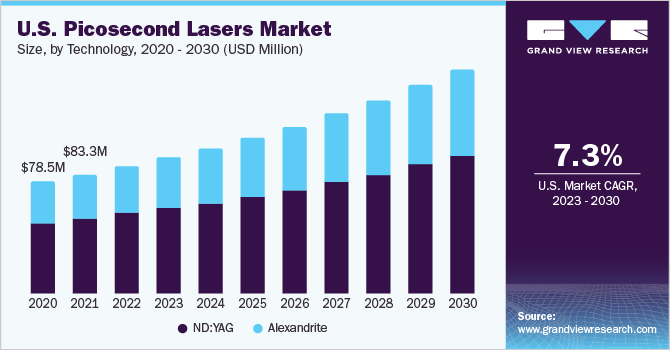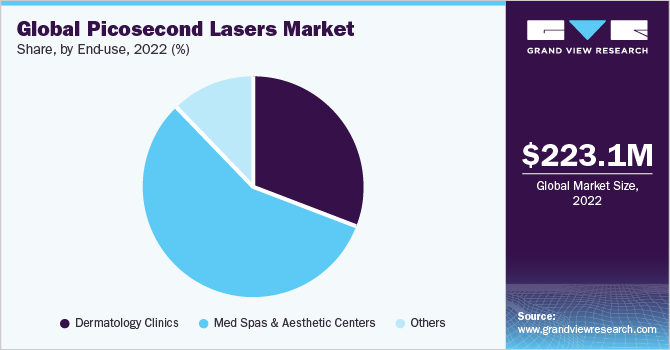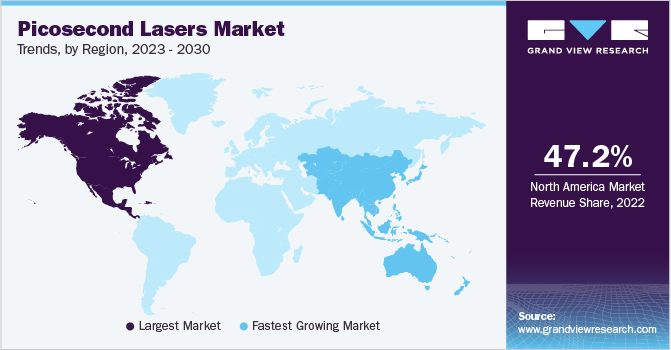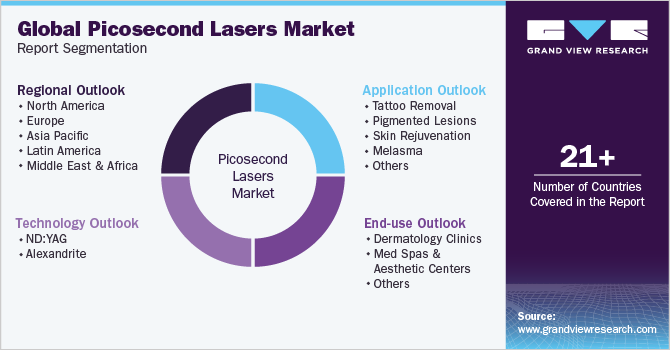
Picosecond Lasers Market Size, Share & Trends Analysis Report By Technology (ND:YAG, Alexandrite), By Application (Tattoo Removal, Melasma), By End-use, By Region, And Segment Forecasts, 2023 - 2030
- Report ID: GVR-4-68040-099-0
- Number of Pages: 100
- Format: Electronic (PDF)
- Historical Range: 2018 - 2021
- Industry:Healthcare
Report Overview
The globalpicosecond lasers market sizewas estimated atUSD 223.1 million in 2022and is projected to grow at a compound annual growth rate (CAGR) of 7.4% from 2023 to 2030. Picosecond laser belongs to the category of ultrafast lasers, which emit optical pulses between 1 picosecond to some tens of picoseconds. The market is expected to witness growth due to several factors such as an increase in procedures for tattoo removal, recognition of picosecond lasers as a treatment for various dermatological ailments such as melasma & solar lentigines, and growing awareness and adoption ofnon-invasive aesthetic treatment. In addition, compared to traditional lasers, picosecond lasers offer shorter pulse durations, which minimize heat buildup in the skin and reduce the risk of adverse effects. It allows patients to undergo treatments with less downtime and discomfort.

The pandemic hurt the picosecond lasers industry. Various voluntary patient procedures were halted, which negatively impacted the growth. Elective surgical cosmetic procedures were halted for 8.1 weeks in 2020 within the U.S., resulting in lower patient turnout. For instance, as per the American Society of Plastic Surgeons, laser tattoo removal procedures performed in the U.S. decreased by 7% in 2020 than in 2019. However, the market recovered from the pandemic losses due to changing customer perception levels. As per the American Society of Plastic Surgeons survey in 2020, 11% of respondents indicated higher adoption ofcosmetic surgeriesin 2021 and in the coming years.
The growing number of tattoo removal procedures is expected to drive market growth. The prevalence of “tattoo regret” in millennials propels the need for picosecond lasers. For instance, in August 2019, Dermatology & Laser Surgery Center stated that an estimated 30% of U.S. adults have one or more tattoos. However, 25% of them indicated to remove those tattoos. In addition, the growing medical literature approves using these lasers for this dermatological condition with significant effectivity and safety recorded in patient trials.
The increasing recognition of picosecond lasers to treat various dermatological conditions and the integration of different laser types in a single product aids the market growth of picosecond lasers. For instance, a trial conducted by the American Society of Laser Medicine and Surgery, Inc. between April 2021 and January 2023 stated a mean improvement of 26% to 50% in patients suffering from café-au-lait macules when treated with PicoWay 730nm. Moreover, market leaders are upgrading their established products to increase their efficiency and treat various dermatological conditions.
Technology Insights
ND: YAG段微微秒激光主导industry with a revenue share of 63.1% in 2022. ND:YAG or neodymium-doped yttrium aluminum garnet crystal emits 532 nm and 1064nm lasers along with a combination of unique wavelengths to treat different dermatological conditions and procedures. For example, ND:YAG picosecond lasers working at 1064-532 nm effectively remove tattoos with minimal or no scarring across skin types and tattoo colors. In addition, these lasers assure fewer sessions with significant visual improvements than that of other laser systems in the market.
The alexandrite segment is estimated to witness the fastest CAGR of 7.8% during the forecast period. The growth of the segment can be attributed to the increasing medical literature supporting the use of alexandrite lasers to treat post-inflammatory hyperpigmentation (PIH). For instance, in July 2021, Dove Press Ltd published a study concluding that a 755-nm alexandrite picosecond laser in conjunction with a diffractive lens offers significant improvement in PIH treatment. Similarly, the laser proved efficacious in the treatment of melasma in Asian patients.
Application Insights
Based on application, the market for picosecond lasers is segmented into tattoo removal, pigmented lesions, skin rejuvenation, melasma, and others. Tattoo removal dominated the market with a revenue share of 41.1% in 2022 and is estimated to grow at the fastest CAGR of 8.3% during the forecast period. Picosecond lasers are distinguished as a “gold-standard” laser for removing tattoos of different colors and skin types. The shorter pulse duration offered by picosecond lasers improves its efficacy during the process. Furthermore, tattoo removal was conferred as “1a” according to the level of evidence, thereby confirming their use in the marketplace.
Moreover, pigmented lesions application is expected to offer significant growth opportunities during the forecast period. According to the article published in the Korean Society for Laser Medicine and Surgery, a 250-picosecond laser was deemed effective in treating pigmented lesions. Furthermore, the study indicated that using a low wavelength picosecond laser to treat pigmented lesions offers better results; thereby, manufacturers are anticipated to target their product launch in this wavelength to improve clinical outcomes from a picosecond laser.
End-use Insights
Based on end-use, the picosecond laser market is segmented into dermatology clinics, med spas & aesthetic centers, and others. Med spas & aesthetic centers dominated the market with the largest revenue share of 56.6% in 2022. The segment is estimated to grow at the fastest CAGR of 8.0% during the forecast period.Medical spasoffer various benefits for cosmetic procedures such as skin rejuvenation, acne treatment, and others.

Moreover, according to American Med Spa Association (AMSA), a significant increase in demand has been noticed for minimally invasive treatments such as tattoo removal and skin enhancement. Furthermore, the growing single-ownership trend in the med spas aids the segment growth. For instance, as per the ASMA report in 2022, an estimated 66% of medical spas in the country were deemed under a single owner, with a majority of ownership under non-MD/surgeons.
Regional Insights
North America dominated the global picosecond laser Industry with a revenue share of 47.2% in 2022. This share is attributed to the high acceptance rate for cosmetic surgeries amongst the population, technological advancements in both surgical and non-surgical techniques, and accessibility and availability of skilled professionals for different dermatological conditions. For instance, according to the American Society of Plastic Surgeons, an estimated 215,898 laser tattoo removal procedures were performed in the U.S. in 2019. In addition, an estimated 997,245 laser skin resurfacing procedures were performed in 2020 in the U.S.

The Asia Pacific region is expected to witness the fastest CAGR of 8.4% over the forecast period. The growth of the regional market can be attributed to the increasing importance of physical appearance, increasing penetration of social media in lifestyle, and technological advancements. For instance, as per Japan Today’s article in 2022, a significant increase in tattoo removal was noticed among the Vietnamese post-Japan’s removal of COVID-19 restrictions.
Key Companies & Market Share Insights
The market is highly competitive with a large number of manufacturers. The market players are focusing on various strategic initiatives such as new product launches, geographical expansions, mergers & acquisitions, collaborations, product upgrades, and partnerships. For instance, in June 2022, Cynosure, LLC announced an upgrade to its PicoSure Pro Device. The device featured a 50% increase in energy with adjustable fluence to increase patient turnover while aiding to treat dermatological conditions such as unwanted pigmentation and skin revitalization for all skin types. Some of the key participants in the global picosecond lasers market include:
Cynosure, LLC.
Cutera
Candela Corporation.
Rohrer Aesthetics, Inc.
Beijing ADSS Development Co., Ltd
Fotona
Lutronic
El.En. S.p.A. Cod.
Alma Laser (Sisram Medical)
Picosecond Lasers MarketReport Scope
Report Attribute |
Details |
Market size value in 2023 |
USD 237.7 million |
Revenue forecast in 2030 |
USD 392.9 million |
Growth rate |
CAGR of 7.4% from 2023 to 2030 |
Base year for estimation |
2022 |
Historical data |
2018 - 2021 |
Forecast period |
2023 - 2030 |
Quantitative units |
Revenue in USD million, and CAGR from 2023 to 2030 |
Report coverage |
Revenue forecast, company ranking, competitive landscape, growth factors, and trends |
Segments covered |
Technology, application, end-use, region |
Regional scope |
北美;欧洲;亚太地区;拉丁美洲; MEA |
Country scope |
U.S.; Canada; Germany; UK; France; Italy; Spain; Norway; Denmark; Sweden; China; Japan; India; Australia; Thailand; South Korea; Brazil; Mexico; Argentina; South Africa; Saudi Arabia; UAE; Kuwait |
Key companies profiled |
Cynosure, LLC.; Cutera; Candela Corporation; Rohrer Aesthetics, Inc.; Beijing ADSS Development Co., Ltd; Fotona; Lutronic; El.En. S.p.A. Cod.; Alma Laser (Sisram Medical) |
Customization scope |
Free report customization (equivalent up to 8 analyst's working days) with purchase. Addition or alteration to country, regional & segment scope. |
Pricing and purchase options |
Avail customized purchase options to meet your exact research needs.Explore purchase options |
Global Picosecond Lasers Market Report Segmentation
This report forecasts revenue growth at global, regional, and country levels and provides an analysis of the latest industry trends in each of the sub-segments from 2018 to 2030. For this study, Grand View Research has segmented the global picosecond lasers market report based on technology, application, end-use, and region:

Technology Outlook (Revenue, USD Million, 2018 - 2030)
ND:YAG
Alexandrite
Application Outlook (Revenue, USD Million, 2018 - 2030)
Tattoo Removal
Pigmented Lesions
Skin Rejuvenation
Melasma
Others
End-use Outlook (Revenue, USD Million, 2018 - 2030)
Dermatology Clinics
Med spas and Aesthetic Centers
Others
Regional Outlook (Revenue, USD Million, 2018 - 2030)
North America
U.S.
Canada
Europe
UK
Germany
France
Italy
Spain
Sweden
Norway
Denmark
Asia Pacific
China
Japan
India
Australia
Thailand
South Korea
拉丁美洲
Brazil
Mexico
Argentina
Middle East and Africa
Saudi Arabia
南非
UAE
Kuwait
Frequently Asked Questions About This Report
b.North America dominated the global picosecond lasers market and accounted for 47.2% of the total market share in 2022.
b.The global picosecond lasers market size was estimated at USD 223.1 million in 2022 and is expected to reach USD 237.7 million in 2023
b.The global picosecond lasers market is expected to grow at a compound annual growth rate of 7.4% from 2023 to 2030 to reach USD 392.9 million by 2030.
b.Some prominent players of picosecond lasers are Cynosure, LLC., Cutera, Candela Corporation, Rohrer Aesthetics, Inc., Beijing ADSS Development Co.,Ltd, Fotona, Lutronic, El.En. S.p.A. Cod., Alma Laser (Sisram Medical), and others.
b.The market is expected to witness growth due to several factors such as growing procedures for tattoo removal, recognition of picosecond lasers to treat different dermatological ailments such as melasma & solar lentigines, and growing awareness and adoption of non-invasive aesthetic treatment.





